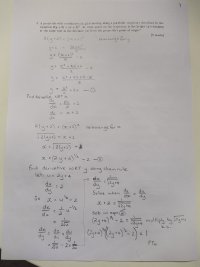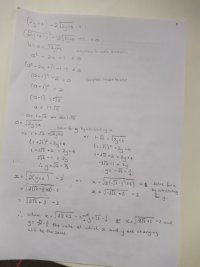trainee engineer
New member
- Joined
- May 16, 2022
- Messages
- 11
Good Afternoon everyone
I am learning calculus for the first time and have come across a problem in my homework assignment that is giving me some trouble.
The problem is as follows:
A projectile with co-ordinates (x, y) is moving along a parabolic trajectory described by the equation [math]2(y+2)=(x+2)^2[/math]. At what point on the trajectory is the height (y) changing at the same rate as the distance (x) from the projectile's point of origin.
I have been stuck with this but I first rearranged the equation for both x and y
[math]y=(x^2)/2+2x[/math] and [math]x=\sqrt{2(y+2)}-2[/math]
Then I derived both to get the equations for the rate of change for each variable with respect to the other.
[math]\frac{dy}{dx}=x+2[/math] and [math]\frac{dx}{dy}=\frac{1}{\sqrt(2(y+2))}[/math]
I was able to create a quadratic to use to solve for y and then substituted back to get x.
This has given me several possible solutions but I am confused and don't understand this.
I have attached my working in the files.
I am learning calculus for the first time and have come across a problem in my homework assignment that is giving me some trouble.
The problem is as follows:
A projectile with co-ordinates (x, y) is moving along a parabolic trajectory described by the equation [math]2(y+2)=(x+2)^2[/math]. At what point on the trajectory is the height (y) changing at the same rate as the distance (x) from the projectile's point of origin.
I have been stuck with this but I first rearranged the equation for both x and y
[math]y=(x^2)/2+2x[/math] and [math]x=\sqrt{2(y+2)}-2[/math]
Then I derived both to get the equations for the rate of change for each variable with respect to the other.
[math]\frac{dy}{dx}=x+2[/math] and [math]\frac{dx}{dy}=\frac{1}{\sqrt(2(y+2))}[/math]
I was able to create a quadratic to use to solve for y and then substituted back to get x.
This has given me several possible solutions but I am confused and don't understand this.
I have attached my working in the files.


